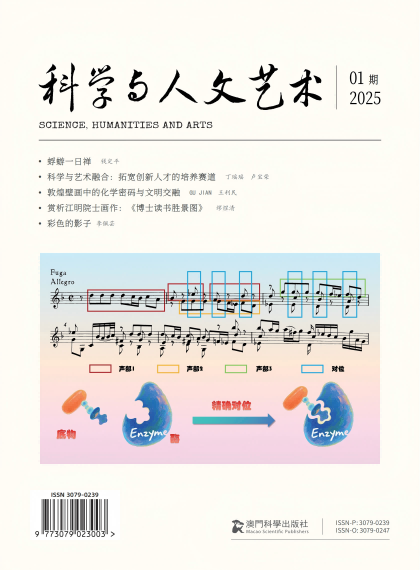
The Chemical Ciphers and Civilizational Convergence in Dunhuang Murals —— An Epic of Humanity Etched in Mineral Crystals
当灯光穿过第257窟的九色鹿画像,鹿身闪现青黑色、红斑变黯褐......这并非画家失误,是千年的颜料遇见岁月奇缘后的自白。敦煌壁画颜料层是时光磨成的文明密码。斑驳且耀眼的点彩色泽旋转出裹挟着星辰的历史长河,丝路物产汇聚于一方衡尺,画面道不明书不尽者便是千年来丝路上人来人往汗津腾挪中相互尊重的学习与较量、彼此滋润的认识与启发。
一、丝路上流动的颜料库
“敦,大也;煌,盛也”——这座以壮阔之名立世的西北重镇,雄踞甘肃省西北隅,扼守河西走廊西端咽喉。黄沙环绕其侧,北临戈壁瀚海,南倚祁连雪峰,自汉唐以降便是贯通中西的枢纽要冲。
秦末汉初,匈奴以铁骑践踏月氏故地,占领敦煌,将其收入右贤王治理范畴。直到汉武帝元狩二年(前121),骠骑将军霍去病挥师西征,击败浑邪、休屠二王,驱逐四万余名匈奴铁骑内附。随后的大汉朝廷,分设敦煌郡,下辖敦煌、渊泉、肩水、陇门、玉门、北路等六县,玉门关与阳关雄姿英发,威严耸立;长城、烽燧绵延千里,驿递人马,络绎不绝。屯田戍边和移民实边让敦煌安下家,而两国互通有无的丝绸在敦煌的驼铃声中穿梭,敦煌逐渐成为中国内地通往西域、希腊、西亚等地的一颗璀璨的明珠。
敦煌莫高窟现存洞窟735个、壁画4.5万平方米、彩塑2415身。从公元366年前秦沙门乐僔开凿第一个洞窟起,经过十六国、北魏、隋、唐、五代、宋、西夏、元近1000年的营造,形成了规模宏大的石窟群。当时,敦煌既是粟特商队往来国际贸易的重要节点,又是玄奘东归途中的停顿站,还是这里会集玄奘译经弘法的所在及多种文明交汇融通之地,在此流传过诸多故事,在《旧唐书・地理志》和敦煌文献P.2005号《沙州都督府图经》中都有详细记载。
敦煌壁画中使用的矿物色谱是阿富汗青金石((Na, Ca)8(AlSiO4)6(S, Cl, SO4, OH)2)和中国辰州朱砂(HgS),由阿富汗通过吐蕃人经营的丝绸之路贸易网和丝绸之路吐蕃贸易网贸易网络被粟特商人用以运抵敦煌[1-2] 。其中从帕米尔高原往下的运输路线分南北两路分别到达敦煌:北路路线是从帕米尔高原出发,顺着泽拉夫善河谷一路到达河中地区的疏勒国、龟兹国,经西域北道进入敦煌境内;南路路线则是先从帕米尔高原翻越大雪山到犍陀罗地区,再到达于阗国、且末等南道绿洲之后继续往东走到达敦煌境内。粟特人以撒马尔罕为中心,运起了有组织的骆驼商队,把从碎叶启程开始经西域城邦于阗国、龟兹国转运上的青金石原料经河西走廊运送到了长安一带。而吐蕃人开辟出来的唐蕃古道另辟蹊径,把阿富汗的矿料和高原上用来烹煮牛奶和羊奶的羊毛脂混合制成膏状的颜料,通过帕米尔高原,穿过塔里木盆地的如若羌一样的渺无人烟之地最后抵达敦煌画工之手,变成一副副令人眼花缭乱的敦煌壁画。
现代科技让我们有了信物确凿的证据:通过对所含青金石晶体锶、钡的同位素比值(Sr/Ba=0.8-1.2)检测可知,这一片敦煌壁画所用的矿物颜料,同阿富汗萨雷沙特格矿脉所产的完全一致。[3] 因而,这条萦回两千多公里之遥的颜料之路既是物质的商旅往来之路,也是技术交流之路、文化融汇之路;盛唐时期,或是粟特人聪明的商贸方式,或吐蕃人高超的高原运输技术,亦或是西域的中转之法,联袂谱就一部丝绸之路上中西文明互通有鉴的华美乐章。
中国辰州朱砂(HgS)以长江水系与陆路联运为基础:自沅江、乌江顺流而下,过洞庭湖转入长江,止于荆州(今湖北江陵),然后陆路南下南阳盆地进长安。或朱砂和粟特商队于长安或河西相会,沿河西走廊主线(凉州一甘州-敦煌)或吐蕃支线(唐蕃古道一青海一西域)至敦煌。粟特商队以撒马尔罕为中心,经由骆驼队过帕米尔高原,将朱砂同中亚香料、贵金属等互易,并运送至长安、东土等地;吐蕃则占据青藏高原,将朱砂从拉萨转至尼泊尔或利用西域道与粟特商队联手打造“高原丝绸之路”;敦煌作为颜料加工中心,工人使用“水飞法”提炼朱砂,并通过粟特人的技术传入中国,在后来形成“朱膘”“朱磦”作为壁画颜料[4] ;这条线路又重新翻新了传递楚地“中国红”文脉向欧亚大陆的途径,以红色代表着佛教画符上文汇影的寓意。
二、色彩嬗变的化学诗篇
第220窟《药师经变》所画的菩萨璎珞细密璀璨,据王旭东等研究者的观察,它们的翠色经过千年累代的化学演变成靛蓝的颜色(图1)。这些苌璘的翠色变成靛蓝的重要原因,还是由于崖面及内部,因潮湿空气的交替进入而产生了结晶相变。从王旭东等人做的XRD图可以看出,画面上颜料表层碳酸盐的含量增加达到了27%[5] ,这就是说:壁画周围的微环境水通过画面上细微裂隙不断向里渗透,引发细小粒度的矿物发生离子迁移和再结晶,也就是说水分子不断进入粒度极小的颜料粒子内部,然后按照一定的温度湿度环境发生铜离子的重组后再结晶,形成了不同的铜矿物晶系。
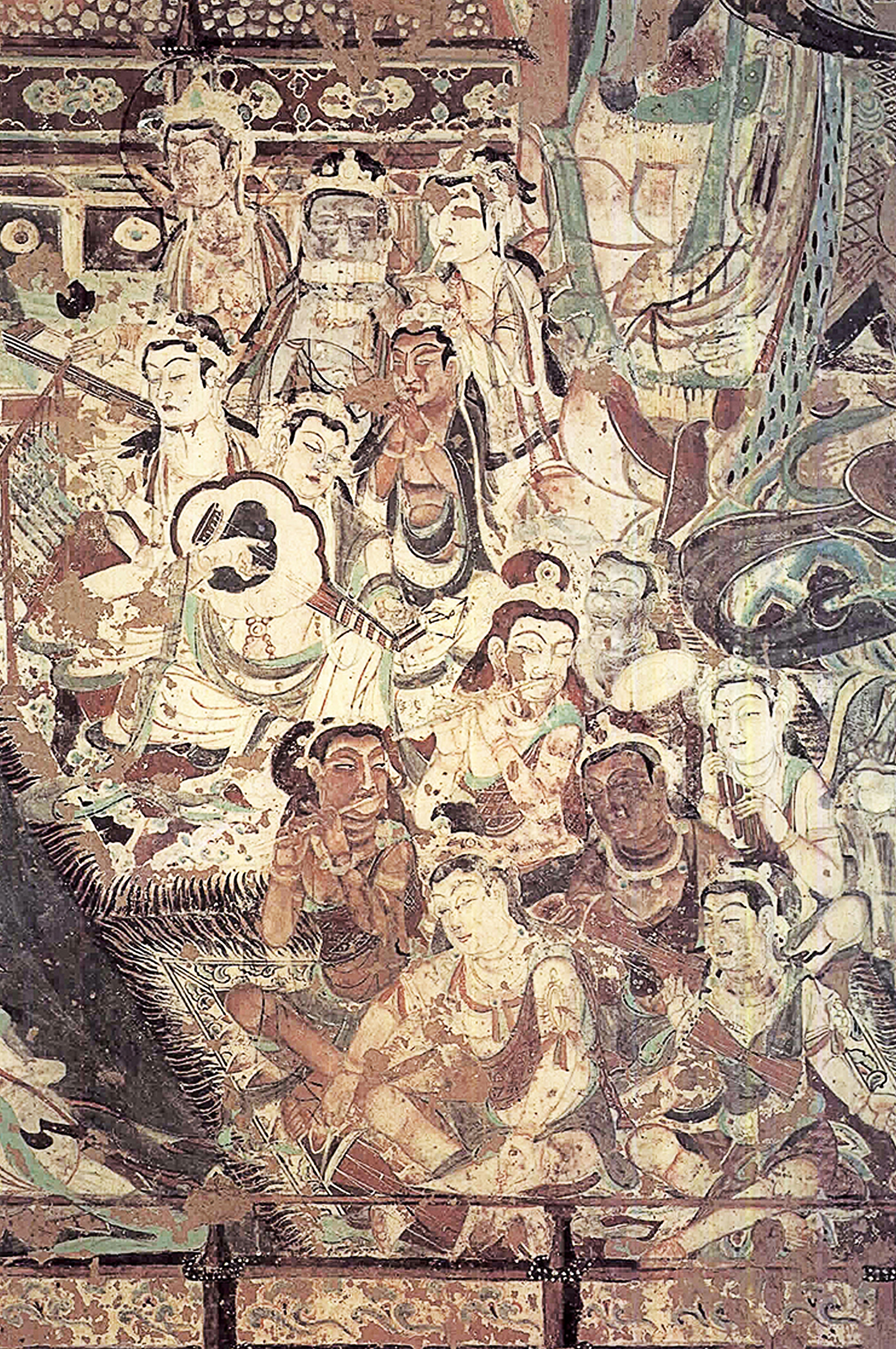
图1. 敦煌莫高窟第220窟,北璧药师经变东侧,乐队,初唐(图片来自www.infzm.com)
不是偶然地出现了颜色变化,这是敦煌独有的“呼吸机制”:由于洞窟内昼夜温差的变化,洞窟内产生了岩体微环境的振动。白天,阳光把洞窟烤得温度升高,在洞窟内形成了保护膜;夜晚,洞窟外面吹来的寒潮又把湿气带进来,湿润颜料的里层。通过这种干湿的反复交替,在一段时间内,在微观层面上,孔雀石晶体内部发生的离子构效,慢慢实现了这个颜色的转变。这就是王旭东他们发现的,除了根本的风化之外,是由壁画本身的这种结构特点,再加之丝路多元文明所衍生的一种现象。粟特商人带来了颜料配方,波斯画师带来的是岩彩的绘画技法,还有中原地区画匠带来了一种敷色的方法。它们来到这种特殊微环境中形成了这个天然的调色盘。从孔雀石到蓝铜矿,这种微妙的颜色渐变过程,就跟佛教艺术本身从犍陀罗的文化样式,最后被汉地所完全取代的这个过程是一样的。某种样式在时间的过程中式微,但它的灵魂已经成为新的物质之体现。
由于敦煌壁画的铅白(2PbCO3·Pb(OH)2)面临的是一个极度氧化的腐蚀境地,“化学背叛”自然更加彻底。和硫化氢发生反应后形成铅白的产物PbS,让素白的铅白渐变成一种浅黑;在强碱性环境下释放的碱更使得朱砂被快速氧化降解[6] 。由红外光谱可知铅白老化的产物能使朱砂的氧化速率提高3.6倍[7] ,而这正是第428窟(图2, 3)飞天的朱裙从素雅丹粉变成了浅淡粉白的原因。由于氧化作用带走了朱砂中汞的鲜亮光泽,沉淀下来的则是更为柔和内敛的温润质感。这种变化在河西走廊这样枯燥的环境中一直持续了上千年的时间,不同明暗的色彩方块就像是在历史上碰撞产生的风纹,而在岁月的流逝中反而体现出更为夺目的风采。
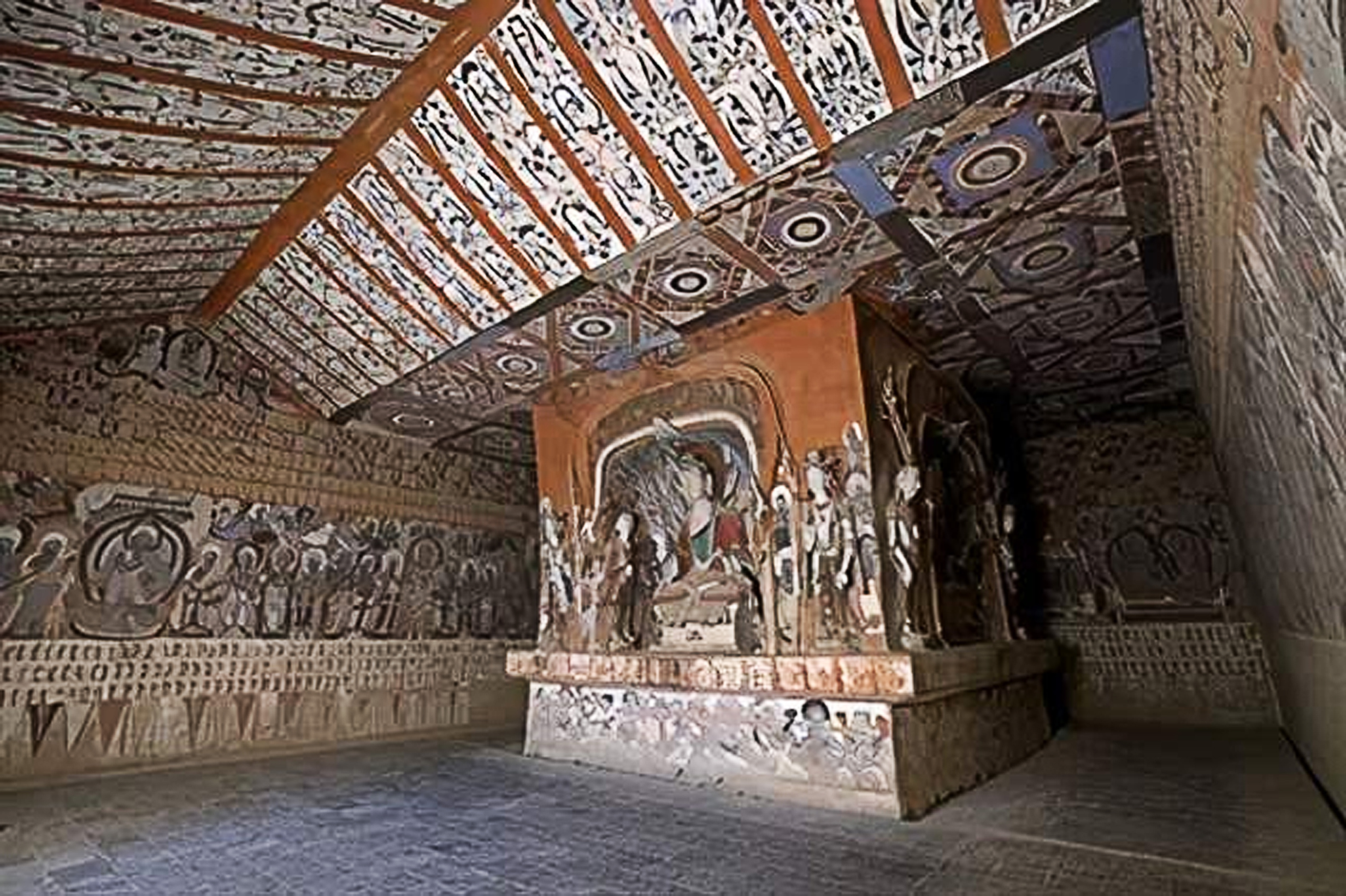
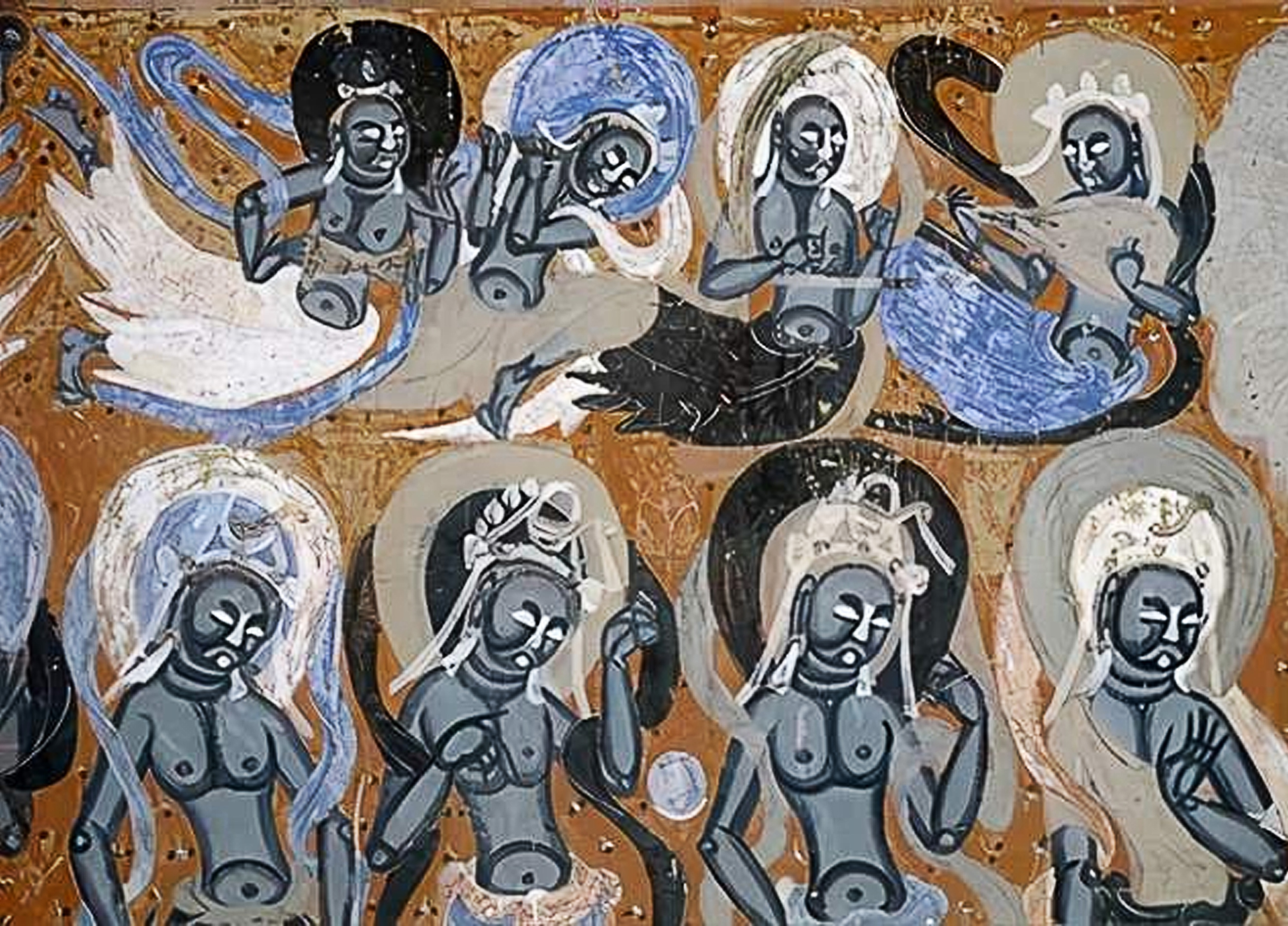
(左)图2. 敦煌莫高窟第428窟主室(图片来自www.163.com);(右)图3. 敦煌莫高窟第428窟飞天与供养菩萨(图片来自www.163.com)
三、科技重绘的文明图谱
敦煌文物保护工作中多光谱成像进入新的认识阶段。在2015年对第254窟尸毗王本生图(唐代)(图4)修复时用3~5 W短波长照射且可穿透8~12 μm厚的PbO2层,检测到光谱灰褐色覆盖层下面的铅丹(Pb3O4)的特征峰,表明残留有63%左右原始赤红色底子[8] 。通过数字修复系统重塑原始色域,使尸毗王割肉的残暴场面焕发出新的震撼力:灰扑扑的蒙昧消失得无影无踪,在一片灼目的红艳里化身聚而不灭的余烬,把悲壮沉郁之美精准地镌刻于每一个看过它的人的视网膜之上。而分布在分子级别的铅丹分子在氧化之后产生梯度色彩层的效果也恰好符合佛教绘画画面由表及里情感发展的过程,PbO2表层的冷灰色和Pb3O4深层的暖红色恰好可以折射出画面形式层面的审美规律和精神层面的内在张力,这里的电子跃迁亦正契合“破执”、“证悟”的密宗辩证思想。
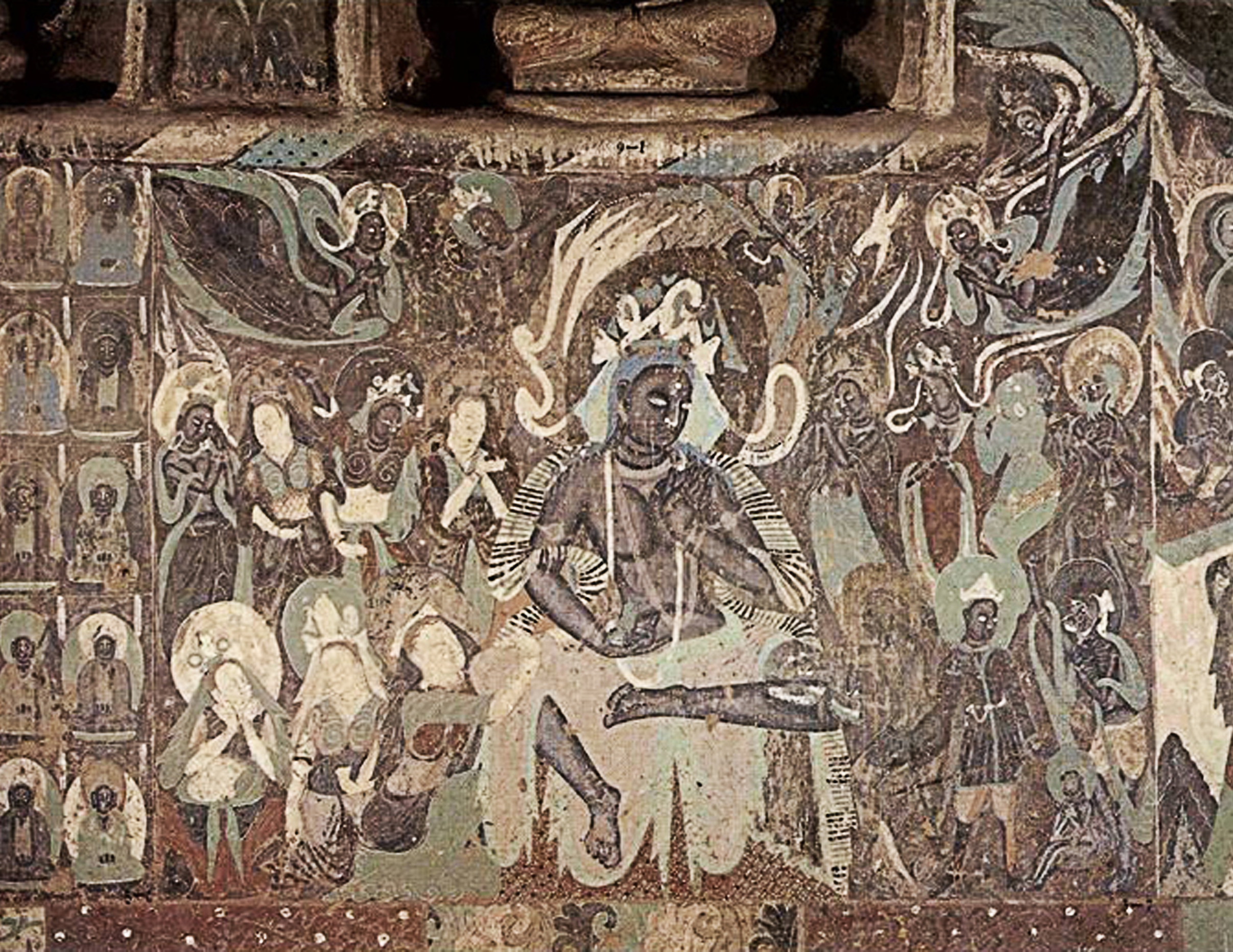
图4. 敦煌莫高窟第254窟,北壁后部中层东端,尸毗王本生,北魏 (图片来自www.infzm.com)
在莫高窟第285窟(图5)西魏飞天群青颜料层中,同步辐射X射线荧光光谱发现波斯钴料(Co/Al=0.15)和本地合成青金石(S/Si=0.08)共生,并处于α-Fe2O3和蓝色颜料(MOS2)的晶界态[3] 。能谱测试结果表明,在此处颜料的硫硅比即处于Afghanistan天蓝石矿物和西域人工合成颜料的取值范围内,为丝路颜料的国际贸易研究提供分子级证据。
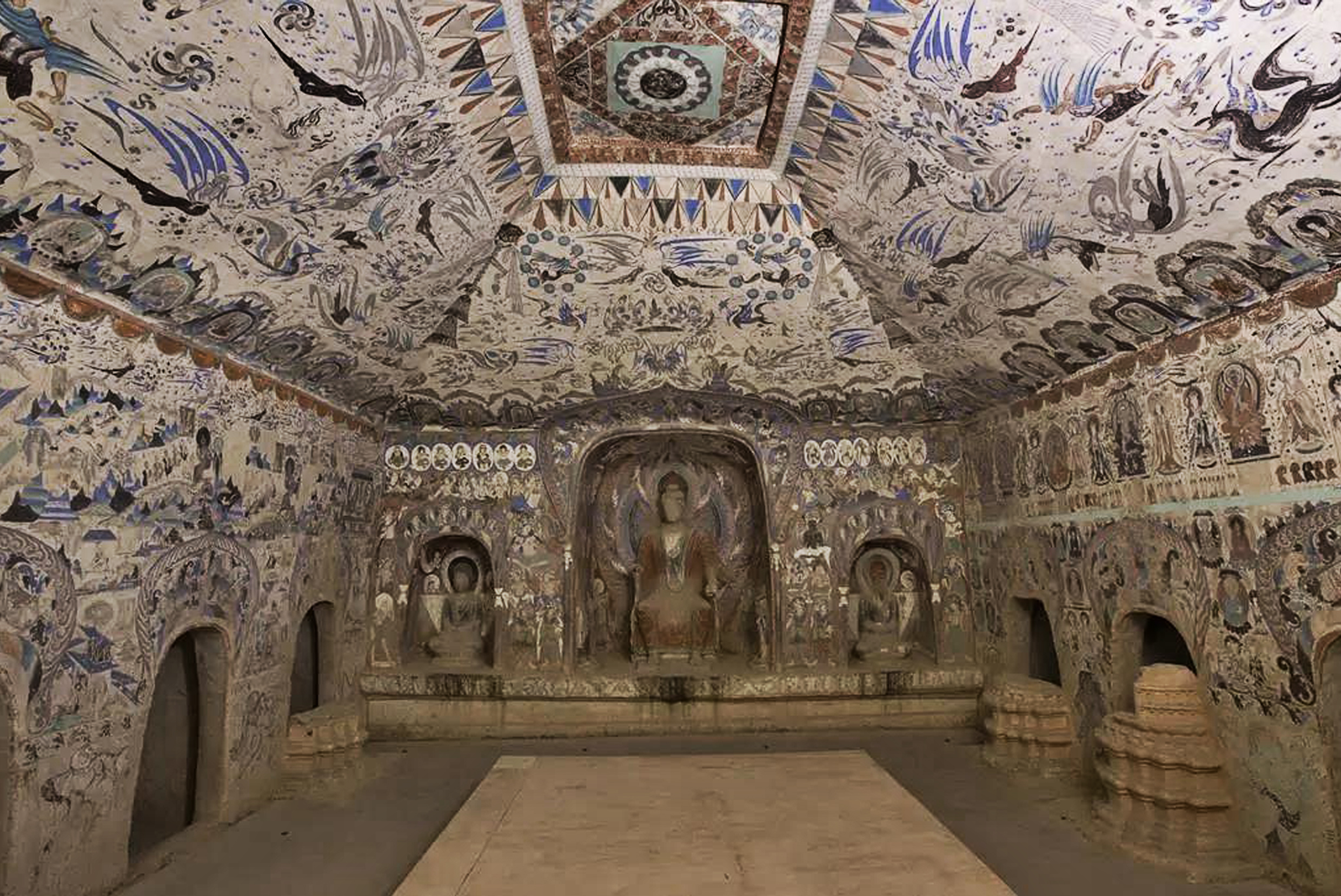
图5. 敦煌莫高窟第285窟,洞窟南壁,五百强盗成佛因缘,西魏 (图片来自www.163.com)
另外,利用SEM-EDS方法,在0.1mm厚的颜料层内发现精巧的三维结构,“青金石-骨胶-黏土”互锁结构[9] 是由青金石颗粒通过骨胶蛋白、黏土矿物相结合而形成的多材料体系,充分发挥了各组分的优势,“青金石-骨胶-黏土”的多重体系使得颜料层有了较强的抗剥落能力;并且粘土矿物所产生的光散射作用也使得此颜料层历经千余年依然保持着较高的色度,能达到原来色度的86%。敦煌壁画工匠将西域钴料研磨配制方法和中原胶黏合技术相融合,创造了流动于丝绸之路上的文明基因,以及在微小世界重组而成的新颖的艺术表达模式。在这样的模式之下诞生的悬浮在骨胶基质之中的异域矿物晶体,是物质的交流,也是文化的借鉴。
四、矿物晶体中的文明基因
汉代曾有烽燧和佛窟并存一时,唐代画师也把祆教的火坛改成莲花座,还有西夏人把新的图像叠绘到旧窟上层,他们尽量保留了原有的色彩。我们称之为“时空叠压”,也是文明接续的智慧,旧基是骨,新彩是肌,叠加在上面才能绽放出不同的生命的姿态。
用拉曼光谱方法研究莫高窟第61窟(图6)五代供养人画像。观察到其中的黄色斑块由印度紫胶(紫胶虫的分泌物,天然有机品红)和中原朱砂(一种无机矿物颜料)间存在层状结构。通过光学显微镜剖面观察表明,紫胶有机层(厚度:3.2±0.5 μm)和朱砂无机层(厚度:7.8±1.2 μm)呈周期性交替排列,使得光的反射率提高了28%[4] 。说明当时的敦煌画工也具有在跨物质界面上实现光学增益的技术。
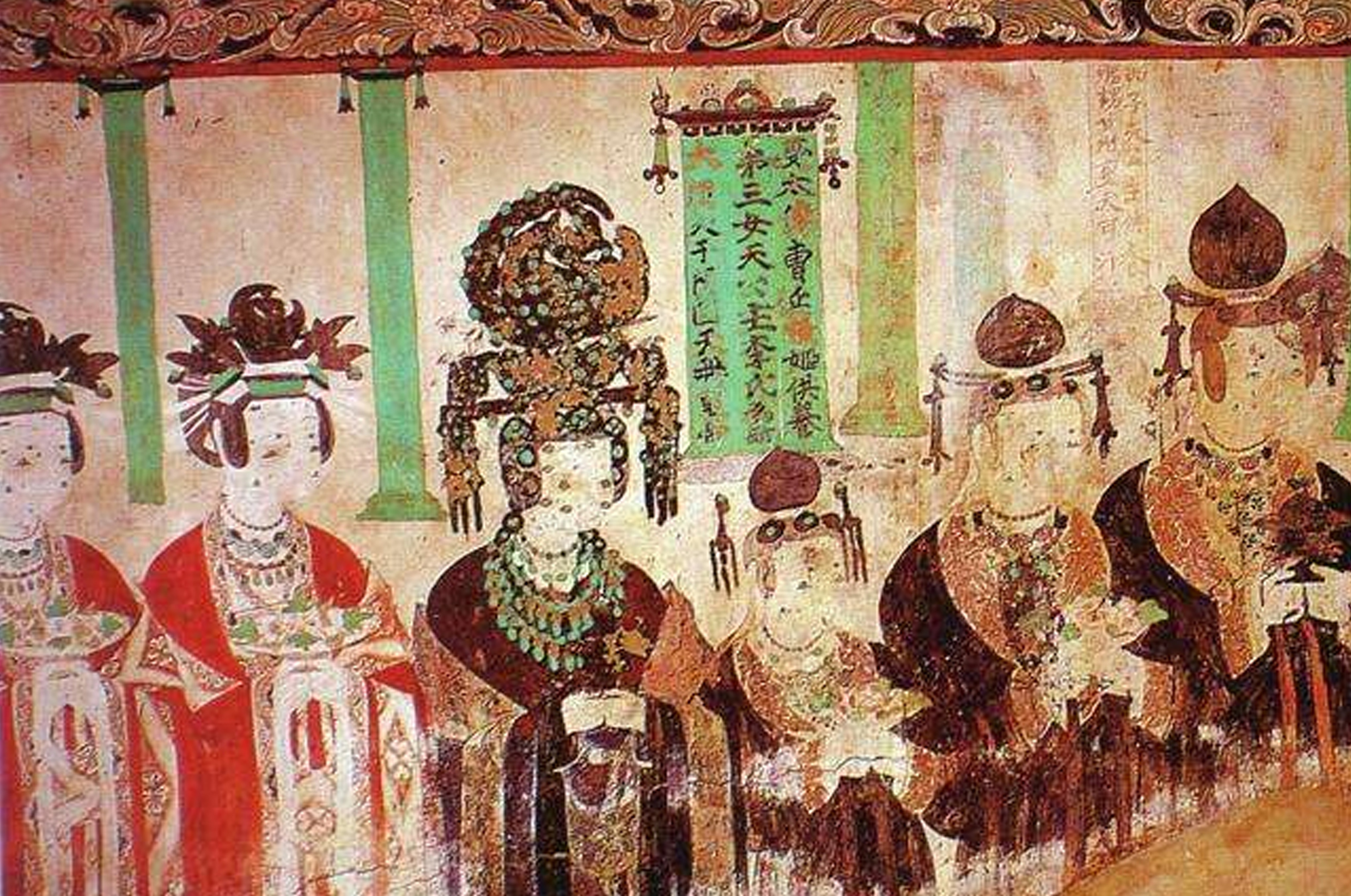
图6. 敦煌莫高窟第61窟曹氏女供养人画像,五代 (图片来自www.sohu.com)
混合吐蕃砗磲粉(文石型CaCO3,晶胞参数a=4.96 Å)和西域铅白(2PbCO3·Pb(OH)2,晶格常数c=9.42 Å)可以得到具有珍珠母贝般光彩的独特白色,并且经XRD分析可知二者在(104)晶面存在0.35%的晶格失配,由于这种受控的晶格畸变使得该混合颜料(质量比为3∶7)的漫反射率下降约17%[10] 。另外,EDS面扫结果显示:海洋生物碳酸钙微球(粒径为5~15 μm)、人工合成铅白片状晶体(厚度为0.3~0.8 μm)在骨胶基质中形成了三维互穿网络结构,结构更加致密、力学性能更好(弹性模量提高约42%),从而使其白色颜料层的附着力达到了约92%,并保持长久稳定。
元代第3窟的《千手观音》(图7),则是科技与艺术并举的艺术珍品。画工们洞悉矿物特性,在元代《千手观音》壁画中使用雌黄(As2S3)和蛤粉(CaCO3)的湿画法制成纳米级黏结层,用X射线衍射等方法研究发现:采用湿画法,雌黄晶体(斜方晶系As2S3晶胞参数a=11.49 Å)和蛤粉(文石型CaCO3,晶格常数c=17.08 Å)间在水介导下形成约80 nm厚的纳米级界面过渡层,在352 cm−1处测得As-S键的特征拉曼峰,在碳酸钙的ν1对称伸缩振动峰(1086 cm−1)处出现3 cm−1红移,说明二者发生了化学键合作用[11] 。当水分子渗入岩壁时,雌黄所含的硫化砷晶体可以在潮湿环境下慢慢舒展开来,与岩壁形成一片细腻的黄色底子;同时,蛤粉中的碳酸钙颗粒也会因遇水而开始轻微溶解,并与岩壁中的钙离子发生离子交换反应,生成牢固的“化学键合”粘结层,“刚柔并济”充分发挥出雌黄色度高且稳定的优点,又能充分利用蛤粉的附着力强和透气好等特点,无论干湿变化都能保证颜料层跟岩壁“同呼吸”。此外,它也能使人们对古代工匠的材料科学水平有更深的认识。
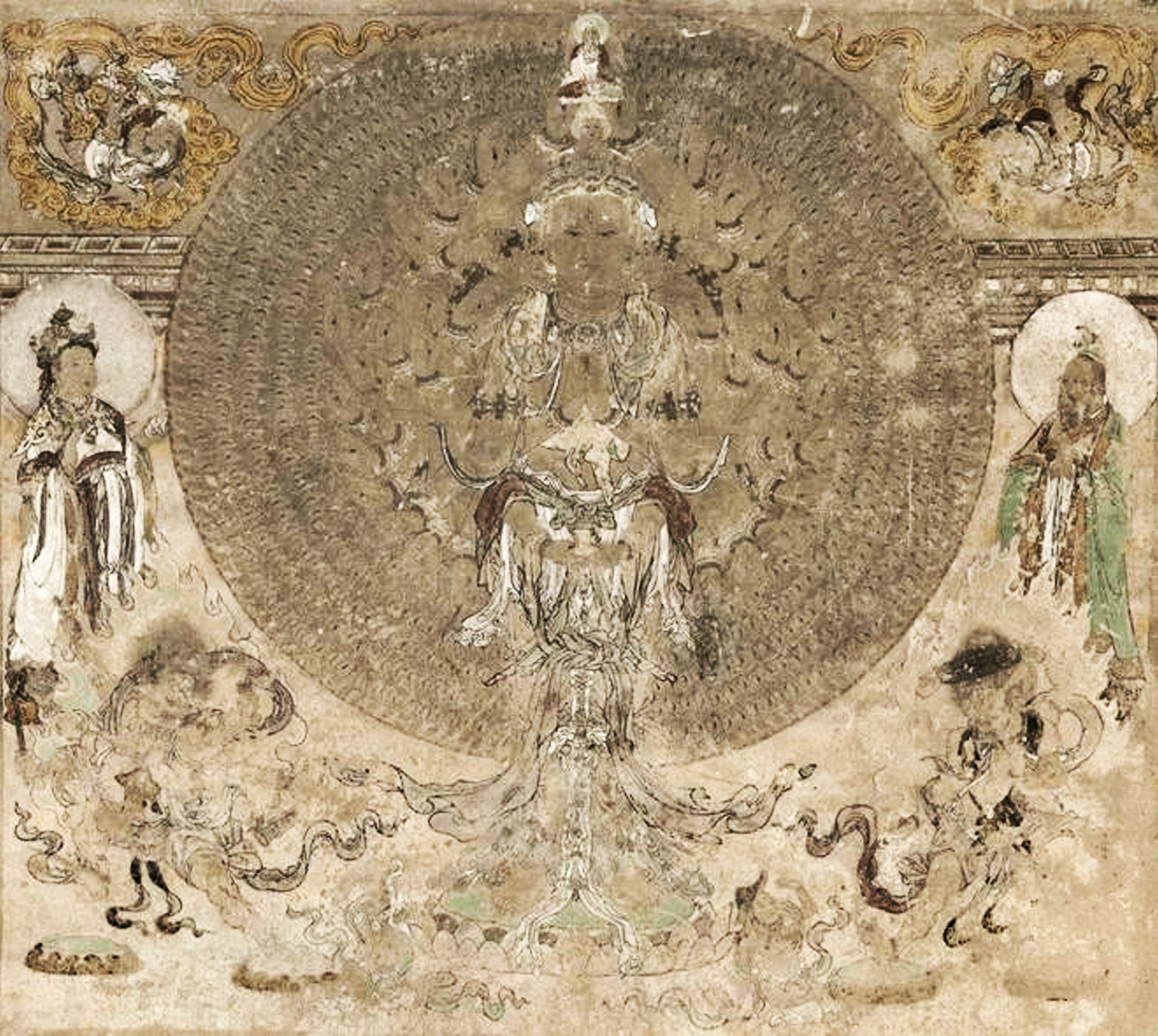
图7. 敦煌莫高窟元代3窟北壁,千手千眼观音图(图片来自www.163.com)
五、结论:千年丝路上的文明交响曲
当鸣沙山晚风轻扬过洞窟飞檐下遮阳避雨的铁马风铃之时,斑驳摩崖壁画兀自倾诉着一句句传颂千古的诗句;敦煌壁画色彩的千变万化既是凝固的视觉史诗,又是一部记录着古今中外民族不断融合的历史图谱;壁画层间含有硫硅共生晶体(S/Si=0.22)的青金石象征着丝绸之路上来往商队所流通的小分子级通关凭证。阿富汗山岩独特的锶钙同位素印记[3] 与长安画师创新性融合和阗矿物颜料研磨工艺,创造出层次分明的叠染技法——这种将西域矿物特性与本土艺术语言相结合的实践,使青金石色相在饱和性与渐变感中达到精妙平衡,最终令中华文明通过矿物基因实现了跨越千年的艺术转译。
如今的光谱技术穿过了斑斓的色彩背后,我们能看到的不仅是几千年以来的矿物质结晶所经历的风雨变幻;更是几千年的时间里,在开放包容的状态下所繁衍的生命的能量密码。我们知道这是披着青金石之光亮盔甲的阿富汗,也知道这描着朱砂的红不是原生的红色,我们知道敦煌壁画正用着现代的语言续写“一带一路”下的新丝路文明故事。我们看铅白的氧化纹路,看青金石的硫硅结晶,知道那是丝绸之路上粟特驼队的脚印、是开放包容后的文明传承。仿生修复材料的运用成功[10] 就告诉我们,只要扬长避短、以客观为主,大胆地采用新方法,在壁画保护工作中就会有新的突破。让传统智慧与现代科技共鸣,丝绸之路的精神火种将会在分子层面重焕生机。
作 者 / Authors:
GU JIAN,澳大利亚人,华东理工大学化学与分子工程学院博士研究生,研究方向为敦煌壁画颜料的成分及其变化。GU JIAN(顾健)出生在中国上海。2001年,毕业于东华大学,获得时装设计学士学位;2005年,在悉尼科技大学取得工商管理硕士学位;2007年,定居上海,并活跃于上海艺术家圈子;2010年5月,在上海莫干山路50号创办了FOR ART GALLERY画廊。她致力于推广中国当代艺术,并促进与世界各地艺术家的交流。她同时也是独立策展人和画家。
王利民,华东理工大学教授 / 博导、中国化工学会精细化工专业委员会委员、全国稀土助染助鞣协作网专家组成员、大连理工大学应用化学 ( 精细化工 ) 博士,美国康乃尔大学化学生物学系以及德国明斯特大学访问学者。开设特色课程《化学与艺术》,将科学和艺术结合起来,带领学生在艺术的氛围中理解科学,在科学中发现艺术的美,在艺术中发现科学的美,同时将中华民族优秀的传统文化融入课程思政中。课程采用影视、动漫、实验、舞台表演等多种方式进行演绎,翻转课堂,现场艺术创作。《中国科学报》、光明网、上观新闻、《青年报》、央广网、学习强国、中国新闻网、科学网、新民网、以及“上海教育”微信公众号、“第一教育”微信公众号等多家媒体报道。